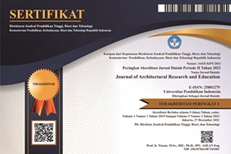CONVERTING OFFICE BUILDING TO RESIDENTIAL USE: IDENTIFYING LOCATION PREFERENCES OF PROSPECTIVE USERS
Abstract
Keywords
Full Text:
PDFReferences
Analisa, F. C. K., & Okada, S. (2023). Tiny house characteristics in Indonesia based on millennial’s user preference. Urban, Planning and Transport Research, 11(1). https://doi.org/10.1080/21650020.2023.2166095
Bahfein, S., & Alexander, H. B. (2021). Hingga Kini, Perkantoran Kosong di Jakarta Mencapai 209 Hektar. KOMPAS.Com. https://properti.kompas.com/read/2021/01/07/135442921/hingga-kini-perkantoran-kosong-di-jakarta-mencapai-209-hektar?page=all..
BPAD. (n.d.). Sejarah Singkat BPAD Provinsi DKI Jakarta. Badan Pengelolaan Aset Daerah Provinsi DKI Jakarta. Retrieved May 31, 2024, from https://bpad.jakarta.go.id/portal/profil#:~:text=BPAD%20merupakan%20unsur%20pelaksana%20fungsi%20penunjang%20urusan%20pemerintahan,dan%20fungsinya%20dikoordinasikan%20oleh%20Asisten%20Perekonomian%20dan%20Keuangan
Byun, G., & Ha, M. (2016). The Factors Influencing Residential Satisfaction by Public Rental Housing Type. Journal of Asian Architecture and Building Engineering, 15(3), 535–542. https://doi.org/10.3130/jaabe.15.535
Cantrell, R. A., & Beall, K. N. (2015). Homebuyer preferences in the post-housing bubble era. Housing and Society, 42(1), 1–16. https://doi.org/10.1080/08882746.2015.1020692
Creswell, J. W., & Poth, C. N. (2016). Qualitative inquiry and research design: Choosing among five approaches. Sage Publications.
Dickson, J., Stein, J., & Strout, B. (2021). Property Owners: It’s Time to Consider Conversions. GLOBEST.COM. https://www.globest.com/2021/02/25/property-owners-its-time-to-consider-conversions/?slreturn=20230931113804
Dunning, R., & Nurse, A. (2021). The surprising availability of cycling and walking infrastructure through COVID-19. Town Planning Review, 92(2), 149–155. https://doi.org/10.3828/tpr.2020.35
Geraedts, R., van der Voordt, T., & Remøy, H. (2018). Conversion Potential Assessment Tool. In Building Urban Resilience through Change of Use (pp. 121–151). Wiley. https://doi.org/10.1002/9781119231455.ch7
Glumac, B., & Islam, N. (2020). Housing preferences for adaptive re-use of office and industrial buildings: Demand side. Sustainable Cities and Society, 62, 102379. https://doi.org/10.1016/j.scs.2020.102379
Gursel, A. P., Shehabi, A., & Horvath, A. (2023). What are the energy and greenhouse gas benefits of repurposing non-residential buildings into apartments? Resources, Conservation and Recycling, 198, 107143. https://doi.org/10.1016/j.resconrec.2023.107143
Ilkovičová, Ľ., Ilkovič, J., & Ivánková, O. (2020). Architectural education for the conversion of old industrial buildings. World Trans Eng Technol Educ, 18, 393-398.
Indraini, A. (2021). Banyak Gedung Kosong, Harga Sewa Perkantoran di Jakarta Terjun. Detikfinance. https://finance.detik.com/properti/d-5323071/banyak-gedung-kosongharga-sewa-perkantoran-di-jakarta-terjun
Irawati. (2023). Kantor Cabang Bank Tutup 4.145 Unit, OJK: Bukan Sepenuhnya Karena Digitalisasi. Infobanknews.Com. https://infobanknews.com/kantor-cabang-bank-tutup-4-145-unit-ojk-bukan-sepenuhnya-karena-digitalisasi/
Jiboye, A. D. (2009). EVALUATING TENANTS’ SATISFACTION WITH PUBLIC HOUSING IN LAGOS, NIGERIA. JOURNAL OF ARCHITECTURE AND URBANISM, 33(4), 239–247. https://doi.org/10.3846/13921630.2009.33.239-247
Kim, E., & Lee, S. (2020). Sustainability and the Expected Effects of Office-to-Residential Conversion in Historic Downtown Areas of South Korea. Sustainability, 12(22), 9576. https://doi.org/10.3390/su12229576
Kumar, R. (2018). Research methodology: A step-by-step guide for beginners. Research methodology, 1-528.
MENPANRB. (n.d.). Pemerintah Matangkan Skenario Pemindahan ASN ke IKN Baru. PANRB. Retrieved May 31, 2024, from https://menpan.go.id/site/berita-terkini/pemerintah-matangkan-skenario-pemindahan-asn-ke-ikn-baru
Midayanti, N. (2021). Hasil Sensus Penduduk 2020.
Muhajirin, M., & Panorama, M. (2017). PENDEKATAN PRAKTIS; Metode Penelitian Kualitatif dan Kuantitatif.
Mungkasa, O. (2020). Bekerja dari Rumah (Working From Home/WFH): Menuju Tatanan Baru Era Pandemi COVID 19. Jurnal Perencanaan Pembangunan: The Indonesian Journal of Development Planning, 4(2), 126–150. https://doi.org/10.36574/jpp.v4i2.119
Pratiwi, W. D., Margono, R. B., Zuraida, S., Kurniawati, I., Tang, A., & Dorothy, E. (2022). Konversi Bangunan Kantor menjadi Hunian: Komparasi Mekanisme Beberapa Negara.
Pratiwi, W. D., Samsirina, N., & Nagari, B. K. (2019). Transformasi Fisik, Teritorial, dan Budaya dalam Permukiman.
Pratiwi, W. D., Zuraida, S., Margono, R. B., Kurniawati, I., Dorothy, E., & Tang, A. (2023). Office Conversion to Residential: Innovation in Housing and Urban Vulnerability (pp. 439–454). https://doi.org/10.1007/978-981-99-1403-6_29
Remøy, H., & van der Voordt, T. (2014). Adaptive reuse of office buildings into housing: opportunities and risks. Building Research & Information, 42(3), 381–390. https://doi.org/10.1080/09613218.2014.865922
Sandi, F. (2020). Bukti Resesi, Perkantoran di DKI Makin Banyak Kosong. CNBC Indonesia. https://www.cnbcindonesia.com/news/20200930152851-4-190656/bukti-resesi-perkantoran-di-dki-makin-banyak-kosong
Savin-Baden, M., & Major, C. (2023). Qualitative research: The essential guide to theory and practice. Routledge.
SmartID. (2023). Inilah Daftar 35 Kementerian dan Lembaga Pemerintah yang Duluan Pindah ke IKN Nusantara pada Tahun 2024 Mendatang. SmartID. https://smartid.co.id/blog/2023/01/27/inilah-daftar-35-kementerian-dan-lembaga-pemerintah-yang-duluan-pindah-ke-ikn-nusantara-pada-tahun-2024-mendatang/
Soliman, A. M., & Alkhalefa, A. M. (2018). CHARACTERISTICS OF SOCIO-ALIVE BUILDING: THE CASE OF BAHRAIN CITY CENTER. JOURNAL OF ARCHITECTURE AND URBANISM, 42(2), 155–168. https://doi.org/10.3846/jau.2018.6142
Tang, A., Kusuma, H. E., & Riska, A. S. (2022a). Hubungan Kausal antara 14 Faktor Preferensi Generasi Y dan Z dalam Memilih Jenis Hunian. ARSITEKTURA, 20(1), 77. https://doi.org/10.20961/arst.v20i1.51415
Tang, A., Kusuma, H. E., & Riska, A. S. (2022b). Preferensi dalam Memilih Hunian Menapak dan Vertikal oleh Generasi Y dan Z di Indonesia. Review of Urbanism and Architectural Studies, 20(1), 87–97. https://doi.org/10.21776/ub.ruas.2022.020.01.9
Titelboim, Y. Y. Y. (2020). Granular urbanism: adaptive strategies for obsolete downtown neighborhoods (Doctoral dissertation, Massachusetts Institute of Technology).
Yust, B. L., & Meghdari, N. D. (2023). Residents’ perspectives of housing needs in an urban neighborhood. Housing and Society, 50(2), 252–272. https://doi.org/10.1080/08882746.2022.2073423
Zivkovic, M., Oliynyk, O., & Murgul, V. A. (2016). Reconstruction of urban areas: sustainable strategy of obsolete building conversion to residential uses. Stroitel'stvo Unikal'nyh Zdanij i Sooruzenij, (1), 102.
DOI: https://doi.org/10.17509/jare.v7i2.85726
Refbacks
- There are currently no refbacks.
Copyright (c) 2025 Journal of Architectural Research and Education

This work is licensed under a Creative Commons Attribution-NonCommercial-ShareAlike 4.0 International License.

This work is licensed under a Creative Commons Attribution-ShareAlike 4.0 International License.








